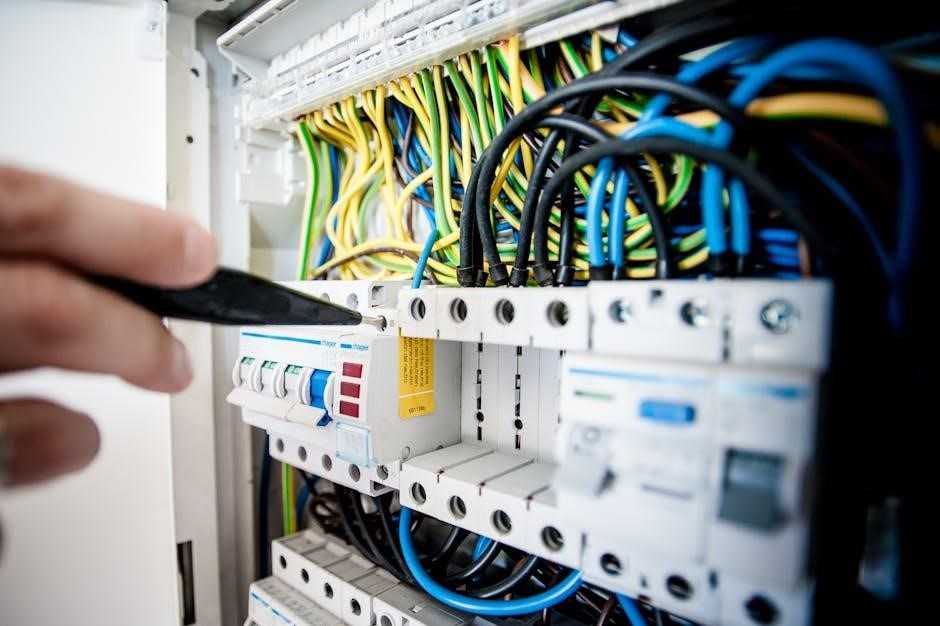The 2017 National Electrical Code (NEC) is a critical document ensuring electrical safety and compliance. It provides updated standards for wiring, grounding, and equipment installation. Available as a free PDF through official NFPA sources, it is essential for electricians and contractors to adhere to modern electrical practices and regulations.
Overview of the NEC and Its Importance
The National Electrical Code (NEC) is a foundational document ensuring electrical safety in residential, commercial, and industrial settings. Published by the National Fire Protection Association (NFPA), it provides comprehensive guidelines for electrical installations, grounding, and overcurrent protection. The NEC is regularly updated to address new technologies and safety concerns. Its adoption is critical for compliance with local and national electrical standards, making it an essential resource for electricians, contractors, and regulatory bodies. The 2017 edition is widely recognized as a benchmark for modern electrical practices.
History and Development of the NEC
The National Electrical Code (NEC) has a rich history dating back to 1897, when it was first published by the National Fire Protection Association (NFPA). Over the years, it has evolved to address advancements in electrical technology and safety. The 2017 edition, developed through a rigorous review process involving public inputs and expert feedback, reflects the latest standards for electrical safety. Its development ensures that the NEC remains a trusted guide for safeguarding people and property from electrical hazards. Regular updates keep it aligned with emerging technologies and industry needs.
Key Changes in the 2017 Edition
The 2017 NEC introduced significant updates, including expanded renewable energy system requirements, enhanced safety standards for smart home devices, and improved guidelines for electric vehicle charging stations.
Major Updates from the 2014 Edition
The 2017 NEC introduced notable changes from the 2014 edition, including expanded requirements for renewable energy systems, enhanced safety measures for arc fault protection, and updated standards for grounding and bonding. New articles addressed emerging technologies like energy storage systems and microgrids. Additionally, there were revisions to rules for circuit breakers, fuses, and surge protection, ensuring safer electrical installations. These updates reflect the evolving landscape of electrical systems and technologies, emphasizing safety and efficiency across residential, commercial, and industrial applications.
New Articles and Revisions in the 2017 NEC
The 2017 NEC introduced five new articles, notably addressing energy storage systems and microgrids. Article 706 covers energy storage, while Article 712 focuses on direct current microgrids. Revisions included expanded GFCI protection requirements, updated surge protection standards, and new rules for emergency disconnects in dwellings. These additions reflect advancements in renewable energy and electrical safety, ensuring the code aligns with modern technologies and hazard mitigation needs, providing a comprehensive framework for safe and efficient electrical installations.
Structure and Organization of the NEC
The 2017 NEC is organized into chapters and articles, providing a logical framework for electrical installations. It includes clear definitions and referenced documents, ensuring easy navigation and compliance with safety standards.
Understanding the NEC Chapters and Articles
The 2017 NEC is structured into nine chapters, each addressing specific aspects of electrical systems. Articles within these chapters provide detailed requirements for installations, ensuring clarity and accessibility. The chapters cover topics such as general requirements, wiring methods, and equipment installation, making it easier for electricians and contractors to reference and apply the code effectively. This logical organization ensures that users can quickly find relevant information, promoting compliance and safety in electrical work. The clear structure enhances the practical application of the code in various settings.
How to Navigate the NEC for Effective Compliance
Navigating the 2017 NEC requires a systematic approach to ensure compliance. Begin with the table of contents to locate relevant chapters and articles. Use the index for quick access to specific topics. Pay attention to updates highlighted in the PDF version, as they indicate key changes from the 2014 edition. Review the general requirements in Chapter 1 before diving into specific sections. Reference tables, diagrams, and annexes for clarification. Always check local amendments, as they may modify NEC standards. Cross-references within the code help guide users to related sections, ensuring comprehensive understanding and adherence to safety protocols.
Safety Regulations and Standards
The 2017 NEC establishes essential safety regulations for electrical installations, ensuring protection from hazards like shock and fire. It applies to residential, commercial, and industrial settings, with updates like GFCI protection and surge requirements. Compliance with these standards is critical for safeguarding lives and property, as outlined in the PDF version of the code.
Residential Electrical Safety Requirements
The 2017 NEC outlines critical safety measures for residential electrical systems, including GFCI protection for outdoor and wet locations, surge protection for dwelling units, and emergency disconnects. These updates aim to reduce fire hazards and electrical shocks, ensuring safer living environments. The code also addresses arc fault protection and tamper-resistant receptacles, which are essential for protecting families. Compliance with these standards is vital for preventing accidents and ensuring reliable electrical systems in homes, as detailed in the 2017 NEC PDF.
Commercial and Industrial Electrical Safety Standards
The 2017 NEC establishes robust safety standards for commercial and industrial settings, focusing on arc fault protection, surge protection, and circuit breaker requirements. It mandates specific wiring methods and grounding practices to ensure reliability and safety in high-power environments. The code also addresses emergency systems and backup power solutions, critical for industrial operations. Compliance with these standards minimizes fire risks, protects equipment, and ensures uninterrupted power supply, aligning with workplace safety guidelines like NFPA 70E, as detailed in the 2017 NEC PDF.

Renewable Energy Systems in the 2017 NEC
The 2017 NEC expands coverage for renewable energy systems, including solar and wind power integration, addressing higher voltage systems previously managed by utilities, as detailed in the PDF.
Solar and Wind Power Integration
The 2017 NEC addresses the growing role of solar and wind power, providing detailed guidelines for their integration into electrical systems. It covers requirements for wiring, grounding, and overcurrent protection specific to renewable energy sources, ensuring safe and efficient installations. The code also includes provisions for higher voltage systems, reflecting the shift toward decentralized energy production. These updates are crucial for contractors, designers, and authorities having jurisdiction to ensure compliance and safety in renewable energy applications, as outlined in the NEC PDF.
Energy Storage Systems and Their Compliance
The 2017 NEC includes specific provisions for energy storage systems, ensuring their safe integration into electrical installations. Article 706 provides detailed requirements for the installation, maintenance, and operation of energy storage systems, addressing both AC and DC systems. It emphasizes proper grounding, overcurrent protection, and thermal management to prevent hazards. These updates align with the growing demand for renewable energy solutions, offering clear guidelines for compliance and safety in energy storage applications, as outlined in the NEC PDF.

Grounding and Bonding Requirements
The 2017 NEC emphasizes proper grounding and bonding techniques to ensure electrical safety. Article 250 provides updated requirements for these systems, reflecting advancements in technology and renewable energy integration.
Grounding Methods and Best Practices
The 2017 NEC outlines essential grounding methods to ensure electrical safety. Proper grounding involves using approved materials like copper or aluminum rods, driven into the earth at specified depths. Best practices include ensuring all metal parts are bonded to the grounding system to prevent voltage differences. Regular inspections and testing of grounding systems are crucial to maintain effectiveness. These practices protect people and equipment from electrical hazards, adhering to the NEC’s safety standards for residential, commercial, and industrial applications. Proper installation and maintenance are vital for reliable operation.
Bonding Requirements for Electrical Systems
The 2017 NEC emphasizes bonding as a critical aspect of electrical system safety. It requires all metal parts of an electrical system, including equipment and enclosures, to be effectively connected to the grounding system. This ensures there are no dangerous voltage differences between components. Proper bonding materials, such as copper conductors, must be used to achieve a reliable connection. Regular inspections are mandated to verify the integrity of bonds. Compliance with these requirements minimizes the risk of electrical shocks and fires, ensuring a safer environment for both people and property. Adherence is non-negotiable for all installations.

Adoption and Enforcement of the NEC
The 2017 NEC is widely adopted by state and local jurisdictions, often with local amendments. Authorities Having Jurisdiction (AHJ) enforce the code to ensure compliance and safety standards.
State and Local Adoption of the 2017 NEC
The 2017 NEC is widely adopted by states and cities across the U.S;, often with local amendments. It serves as the foundation for many state and city codes, ensuring electrical safety and compliance. Jurisdictions may incorporate additional requirements specific to their region. The NEC is updated every three years, with the 2017 edition becoming effective in August 2016. Its adoption varies by state, but it remains a critical standard for electrical installations. Authorities Having Jurisdiction (AHJs) enforce these codes to protect public safety and ensure adherence to electrical standards.
Role of Authorities Having Jurisdiction (AHJ)
Authorities Having Jurisdiction (AHJs) play a crucial role in enforcing the 2017 NEC. These local entities, such as building departments and inspection agencies, are responsible for interpreting and implementing the Code. They ensure compliance with safety standards through inspections and approvals. AHJs also address specific regional needs by adapting the NEC to local conditions. Their decisions are final and binding, making them essential for maintaining electrical safety and protecting the public. Proper documentation and adherence to AHJ rulings are vital for legal and safety compliance.

New Technologies Covered in the 2017 NEC
The 2017 NEC addresses advancements in renewable energy systems, including solar and wind power integration, and energy storage systems, ensuring safety and efficiency in electrical installations.
Smart Home Devices and Automation Systems
The 2017 NEC addresses the integration of smart home devices and automation systems, ensuring their safe installation and operation. It covers low-voltage wiring, network connectivity, and energy management. The Code provides guidelines for remote monitoring and control of electrical systems, promoting efficiency and convenience. Compliance with these standards ensures reliability and safety in smart home technologies, supporting the growing demand for automated living solutions while maintaining electrical safety protocols. This section is crucial for installers and manufacturers adapting to modern smart home innovations.
Electric Vehicle Charging Stations
The 2017 NEC introduces specific requirements for electric vehicle (EV) charging stations, addressing installation, wiring, and safety standards. Article 625 details provisions for EV charging systems, including supply equipment, connectors, and receptacles. The Code ensures safe charging operations, accommodating various charging levels and power requirements. Compliance with these standards supports the growing adoption of EVs while maintaining electrical safety and efficiency. This section is vital for installers and manufacturers involved in EV infrastructure, ensuring reliable and secure charging solutions align with modern technological advancements.

Overcurrent Protection and Circuit Requirements
The 2017 NEC updates rules for circuit breakers and fuses, enhancing safety and reliability. New requirements address arc fault protection, ensuring advanced hazard prevention and electrical system integrity.
Updated Rules for Circuit Breakers and Fuses
The 2017 NEC introduces revised standards for circuit breakers and fuses to enhance electrical safety. New specifications address ratings, installation, and testing to ensure compliance.
These updates reflect advancements in technology and industry practices, providing clearer guidelines for selecting and maintaining overcurrent protection devices.
The changes aim to reduce risks associated with electrical systems, ensuring reliable performance and adherence to modern safety protocols.
Arc Fault and Ground Fault Protection
The 2017 NEC emphasizes enhanced protection against arc faults and ground faults to prevent electrical fires and shocks. New requirements mandate the use of advanced AFCI and GFCI devices.
These technologies detect harmful electrical conditions, interrupting circuits to protect people and property from potential hazards.
Revisions ensure broader coverage in residential and commercial settings, improving safety standards and reducing fire risks associated with faulty wiring or equipment.

Hazardous Locations and Specialized Systems
The 2017 NEC provides guidelines for electrical systems in hazardous locations, ensuring safety in areas with explosive or flammable substances. It classifies locations and outlines equipment installation requirements to prevent ignition risks and ensure compliance with safety standards.
Classified Locations and Explosive Atmospheres
The 2017 NEC classifies hazardous locations into Class I, II, and III based on the presence of flammable gases, dust, or fibers. It provides specific requirements for equipment installation in these areas to prevent ignition of explosive atmospheres. Detailed guidelines ensure safe electrical systems in environments with hazardous materials, protecting people and property from potential fire or explosion risks. Compliance with these standards is essential for maintaining safety in industrial and commercial settings.
Emergency Systems and Exit Lighting
The 2017 NEC emphasizes the importance of reliable emergency systems and exit lighting to ensure safety during evacuations. It specifies minimum illumination levels for exit signs and pathways, ensuring visibility in low-light conditions. Updates include requirements for self-diagnostics in emergency lighting systems and stricter testing protocols. These standards aim to enhance reliability and ensure compliance with safety regulations. Proper installation and maintenance of these systems are critical to safeguarding lives in emergency situations, reflecting the NEC’s commitment to public safety and adherence to modern electrical practices.
NEC and Other NFPA Standards
The 2017 NEC aligns with other NFPA standards, such as NFPA 70E for workplace safety and NFPA 5000 for building construction, ensuring comprehensive electrical safety and compliance.
Relationship Between NEC and NFPA 70E
The 2017 NEC and NFPA 70E are complementary standards. While the NEC focuses on electrical installation requirements, NFPA 70E addresses workplace electrical safety practices. Together, they ensure safe electrical systems and protect workers from hazards like arc flashes and shock. The NEC provides the installation foundation, while NFPA 70E guides safe work practices, including lockout/tagout and personal protective equipment. Their alignment ensures a comprehensive approach to electrical safety, from design to maintenance, safeguarding both systems and personnel.
NEC and NFPA 5000: Building Construction
The 2017 NEC and NFPA 5000 (Building Construction and Safety Code) are complementary standards. While the NEC focuses on electrical systems, NFPA 5000 addresses overall building construction and fire safety. Together, they ensure safe and compliant building design. The NEC specifies electrical installation requirements, while NFPA 5000 provides guidelines for fire-resistant materials, means of egress, and structural integrity. Their alignment ensures comprehensive safety, integrating electrical systems with broader building construction standards for occupant safety and code compliance.

Accessing the 2017 NEC in PDF Format
The 2017 NEC is available as a PDF through official sources like NFPA and ICC. Visit nfpa.org or iccsafe.org, search for the code, select the 2017 edition, and access the free PDF or purchase options.
Official Sources for the NEC PDF
The official 2017 NEC PDF can be obtained from trusted sources like the National Fire Protection Association (NFPA) and the International Code Council (ICC). Visit nfpa.org or iccsafe.org to access the document. These platforms offer secure downloads, ensuring authenticity and compliance. The NFPA website provides a direct link to the 2017 NEC PDF, while ICC Safe offers it as part of their code collection. Always verify the source to avoid unauthorized versions and ensure you’re referencing the correct edition for compliance purposes.
Free Access and Purchase Options
The 2017 NEC PDF is available for free through official sources like the National Fire Protection Association (NFPA) website. Users can access the document by selecting the “View Free Access” option after agreeing to terms and conditions. For purchase, the NEC PDF can be bought from nfpa.org or iccsafe.org, offering secure downloads. The purchased version is delivered as a virus-free file, suitable for Mac or PC. This ensures compliance with the latest electrical safety standards for educational, research, or personal use, adhering to fair use regulations.

Training and Certification Based on the 2017 NEC
NEC 2017 training courses and certification programs are available for electricians and contractors. These programs ensure compliance with updated electrical safety standards and regulations, providing structured learning experiences for practical application.
Available Courses and Workshops
Various training programs and workshops are available to help professionals understand and implement the 2017 NEC. These courses cover code updates, safety practices, and compliance requirements. They are designed for electricians, contractors, and engineers, offering both theoretical and practical knowledge. Many programs are conducted by NFPA-certified instructors and include hands-on exercises. Workshops often focus on specific topics like grounding, overcurrent protection, and renewable energy systems. These resources ensure individuals stay updated on the latest electrical standards and can apply them effectively in real-world scenarios.
Certification Programs for Electricians
Certification programs based on the 2017 NEC are designed to validate electricians’ expertise in code compliance. These programs typically include exams that test knowledge of the NEC, ensuring professionals meet industry standards. Certifications are offered for electricians, contractors, and inspectors, covering topics like grounding, circuit requirements, and safety protocols. Many programs provide study materials, including the NEC PDF, to aid preparation. Certification enhances credibility and career opportunities, demonstrating a commitment to electrical safety and code adherence.

Comparison with Future Editions (2020 and 2023)
The 2020 NEC introduced GFCI protection for sinks and surge protection for dwellings, while the 2023 NEC removed redundant articles like Article 510 and 712, enhancing clarity.
Differences Between 2017 and 2020 NEC
The 2020 NEC introduced significant updates, including GFCI protection for 125-250V receptacles near sinks and surge protection for dwelling units. Emergency disconnects became mandatory for residential units, enhancing safety. These changes reflect advancements in technology and safety standards, building on the foundation established by the 2017 NEC. The 2020 edition prioritized public and worker safety, addressing emerging electrical hazards and integrating modern practices. These updates ensure compliance with evolving electrical demands, making the 2020 NEC a critical step forward in electrical safety and efficiency.
Key Updates in the 2023 NEC
The 2023 NEC introduced groundbreaking changes, including the removal of redundant articles like Article 510 on hazardous locations and Article 712 on microgrids. New provisions focus on emerging technologies, such as electric vehicle charging and energy storage systems. Enhanced safety measures include updated requirements for Arc Fault Circuit Interrupters (AFCIs) and Ground Fault Protection. These updates align with modern electrical demands, ensuring safer and more efficient installations. The 2023 edition emphasizes adaptability to technological advancements, making it indispensable for electricians and contractors.
